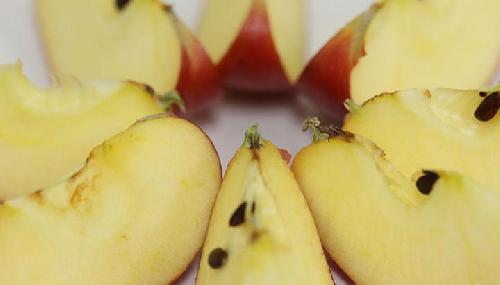Agriculturally rich nations are a little spoiled about food. A few years ago Europe even limited how 'ugly' fruit could be when it was being sold to the public, presumably because Europeans deserve pretty fruit.
For that reason, it's little surprise that there is concern about browning in apples. After being sliced open, the color starts to fade quickly, and in a hyper-vigilant culture where 99 percent of the public has never worked on a farm, parents and consumers may think that this 'browning' means the apple is bad. It gets thrown away, which leads to food waste.
The reason for this ugly coloring is a chemical reaction, which is due to the catalysis caused by the enzyme tyrosinase. Actually, this "browning" is a defense mechanism of plants.
"There are caterpillars which are starving to death with a full stomach, because they are no longer able to digest the material which is altered by the tyrosinase," explains Matthias Pretzler of the Department of Biophysical Chemistry at the University of Vienna, who was involved in the structure elucidation of the first plant tyrosinase.

The tyrosinase, which is a metal-containing enzyme catalyzing the oxidation of phenols, has been explored by Annette Rompel for over 20 years. It is also involved in the synthesis of human melanin and therefore responsible for human "browning" as well. "In the 1990s we were far away from handling the enzyme, but with the development of modern chromatographic and crystallographic methods there are better opportunities available to us today", says Annette Rompel, who already tried to isolate and purify the enzyme from walnut leaves.
After the successful characterization and crystallization of mushroom tyrosinase in 2014, the walnut leaf is the center of her research nowadays. "Walnut leaves make the skin become brown, which proves that they contain a high concentration of the enzyme and represent an attractive source for our research", she explains.
Old theory is replaced by new findings
On the basis of the crystallization of tyrosinase from walnut leaves, the researchers disproved a common theory. The tyrosinase belongs to the enzyme class of polyphenol oxidases. It catalyzes the first two reactions (hydroxylation and oxidation) of the melanin biosynthesis. "Besides the tyrosinase, the so-called catechol oxidase is found in plants, which, however, is only able to catalyse the second reaction (oxidation)", says Matthias Pretzler.
Both enzymes are very similar as far as the structure is concerned.
"This raises the question how the results of the individual reactivities differ from each other," adds Aleksandar Bijelic.
It was previously assumed that tyrosinase differs from catechol oxidase by one single amino acid, which is virtually positioned over the active center like a "plug" and thus responsible for the different reactivities. After the scientists of the University of Vienna have crystallized the first plant tyrosinase, they discovered that both enzyme classes contain this "plug" in plants.
Developing new perspectives
Accordingly, the team shifted its focus from the active site to more distant structural regions of the enzyme. "Our assumption is that some sort of pre-orientation has to take place in order to allow a substrate to gather the active site despite the presence of the 'plug' so that it can be finally converted by the tyrosinase", says the project leader. Thus, the scientists "zoomed out" a little bit and focused towards the amino acids at the second shell, which is located at the entrance of the active site. "In fact, we learned that these amino acids play a more important role than previously assumed."
Published in Angewandte Chemie.




Comments